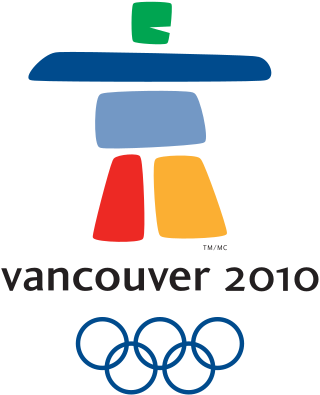
The 2010 Winter Olympics, officially known as the XXI Olympic Winter Games and also known as Vancouver 2010, were an international winter multi-sport event held from February 12 to 28, 2010 in Vancouver, British Columbia, Canada, with some events held in the surrounding suburbs of Richmond, West Vancouver and the University of British Columbia, and in the nearby resort town of Whistler. It was regarded by the Olympic Committee to be among the most successful Olympic games in history, in both attendance and coverage. Approximately 2,600 athletes from 82 nations participated in 86 events in fifteen disciplines. Both the Winter Olympic and Paralympic Games were organized by the Vancouver Organizing Committee (VANOC), headed by John Furlong. The 2010 Winter Games were the third Olympics to be hosted by Canada, and the first to be held within the province of British Columbia. Canada had hosted the 1976 Summer Olympics in Montreal, Quebec, and the 1988 Winter Olympics in Calgary, Alberta.

The 2010 Winter Paralympics, or the tenth Paralympic Winter Games, were held in Vancouver and Whistler, British Columbia, Canada from March 12 to 21, 2010. The opening ceremony took place in BC Place Stadium in Vancouver and the Closing Ceremony in Whistler Medals Plaza.
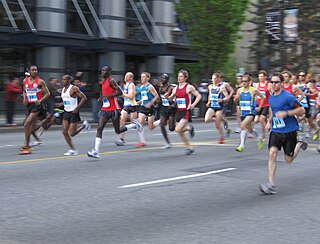
There have been a wide variety of sports in Vancouver since the city was founded. Team sports such as ice hockey, lacrosse, and Canadian football have extensive history in the area, while the city's relatively mild climate and geographical location facilitate a wide variety of other sports and recreational activities.
Since the 1976 Summer Olympics in Montreal, the Royal Canadian Mint has struck Summer and Winter Olympic coins to mark Games held in Canada.
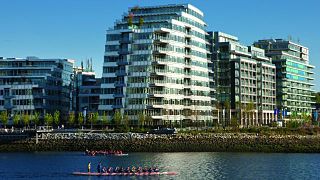
The Vancouver Olympic Village (VVL) is a neighbourhood and Olympic Village built by Millennium Development Group in Vancouver, British Columbia, Canada, originally built for the 2010 Winter Olympics and 2010 Winter Paralympics.
The Royal Canadian Mint has made coins with various themes. Most recently, ice hockey has been used for many numismatic releases. The first known ice hockey coin was for the 1988 Winter Olympics. Issued on February 25, 1986, the coin featured a goalie on the coin. Edge lettering was also used for the coin, the first time that it was used on silver coins.

The Whistler Sliding Centre is a Canadian bobsleigh, luge, and skeleton track located in Whistler, British Columbia, that is 125 km (78 mi) north of Vancouver. The centre is part of the Whistler Blackcomb resort, which comprises two ski mountains separated by Fitzsimmons Creek. Located on the lowermost slope of the northern mountain, Whistler Sliding Centre hosted the bobsleigh, luge, and skeleton competitions for the 2010 Winter Olympics.
The Vancouver Organizing Committee for the 2010 Olympic and Paralympic Winter Games (VANOC) was the non-profit organization responsible for planning, organizing, financing and staging the 2010 Winter Olympics and 2010 Winter Paralympics. Established on September 30, 2003, about four months after the 2010 games were awarded to Vancouver, British Columbia, it performed these roles with "the mandate to support and promote the development of sport in Canada."
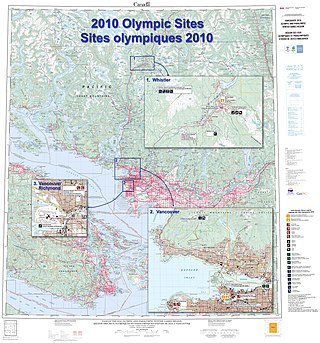
For the 2010 Winter Olympics, a total of ten sports venues were used, seven in Vancouver, and three in Whistler. The majority of ice sport events were held in Vancouver, while Whistler, which normally serves as a ski resort, hosted the snow events. Six non-competition venues, three each in Vancouver and Whistler, provided athlete housing, space for media, and locations for ceremonies associated with the Games.

The Hillcrest Centre is a community centre with ice hockey, curling rinks, and an aquatics facility, located at Hillcrest Park in Vancouver, British Columbia, Canada. Construction started in March 2007; it hosted the 2009 World Junior Curling Championships prior to the Olympics. During the 2010 Olympics, it was named the Vancouver Olympic/Paralympic Centre and had a capacity of 6,000 people to host curling at the 2010 Winter Olympics; for the 2010 Paralympics, it hosted the Wheelchair Curling event.

Leo Obstbaum was an Argentine-born Spanish design director for the 2010 Winter Olympics in Vancouver, British Columbia, Canada, as part of the Vancouver Organizing Committee (VANOC). Obstbaum was responsible for designing many of the main symbols of the Vancouver Olympic Games including the Olympic and Paralympic medals, the design of the 2010 Olympic torch, and the 2010 Winter Olympic and Paralympic Games mascots.

John Wilson "Jack" Poole, was a Canadian businessman who, as the head of the VANOC bid committee, was responsible for bringing the 2010 Winter Olympics to Canada.

At the 2010 Winter Paralympics in Vancouver, British Columbia, Canada, Australia sent 11 athletes to compete against the other participating 42 nations. The delegation consisted of 3 sighted guides and 17 support staff. This was the largest delegation Australia had sent to a Winter Paralympics. Australia has participated in every winter Paralympics since its conception.

Wenlock is the official mascot for the 2012 Summer Olympics, and Mandeville is the official mascot for the 2012 Summer Paralympics, both held in London, England, United Kingdom. Named after Much Wenlock and Stoke Mandeville, they were created by Iris, a London-based creative agency. The mascots were unveiled on 19 May 2010, marking the second time that both Olympic and Paralympic mascots were unveiled at the same time.

Fu Niu Lele, was the mascot of the 2008 Summer Paralympics in Beijing.
Meomi Design Inc. is a Canadian/American design studio based in Vancouver and Los Angeles founded by Vicki Wong and Michael C. Murphy in 2002. Their works include the Vancouver 2010 Winter Olympics mascots Miga, Quatchi, Sumi and Mukmuk, and Octonauts, a series of books which were made into a CGI Animated TV series for the BBC channel CBeebies by Brown Bag Films and Silvergate Media in 2010, subsequently broadcast internationally.
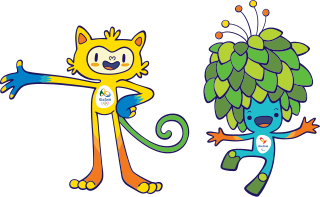
Vinicius is the official mascot of the 2016 Summer Olympics, and Tom is the official mascot of the 2016 Summer Paralympics. Both events were held in Rio de Janeiro, Brazil. The mascots were created by São Paulo-based animation company Birdo, which was selected by a national tender process that began in November 2012. Vinicius' design represents Brazilian fauna, combining aspects of cats, monkeys, and birds, while Tom's design represents Brazilian flora.
2010 Winter Olympics marketing has been a long running campaign that began since Vancouver won its bid to host the games in 2003.













